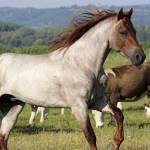Perception of Vitamin E and Selenium on Equine Muscle Problems

One of the most important tenets of medicine is to first do no harm. Veterinarians and horse owners often factor in this belief when making management decisions, particularly if one party wants to try something that may not be specifically indicated but is unlikely to harm the horse.
A placebo is a harmless, inactive treatment used to test the efficacy of an actual treatment. In human medicine it might also be prescribed for the mental relief of the patient. It is difficult to argue against perceived positive results, especially when the horse is performing well.
A team of German researchers investigated the use of vitamin E and selenium supplementation and its effect on the riders’ perceptions of how well their horses responded and performed afterwards. Ninety horses were enrolled in the study, divided into three groups. Most of the horses were show jumpers. All of the riders perceived their horses had some sort of muscle problem. One group was treated with a placebo of soybean meal, gelatin, and sugar. The other two groups received the placebo mixture and either a vitamin E or selenium supplement. The riders were aware that the study involved a placebo treatment, but the study was double-blinded, meaning that neither the researchers nor the riders knew what treatment was given to specific horses.
Vitamin E and selenium concentrations were measured before and after completion of the 120-day study. The riders completed a questionnaire before and after the study that asked about the location and degree of muscle problems as well as the behavior of the horse while being ridden.
The riders identified the back muscles as the muscle group with the most problems, followed by the hamstring muscles. Other muscle groups received lower scores. The riders’ scores for back muscle problems significantly improved at the end of the study. The scores given to other muscle groups improved slightly but were not statistically significant. The riders indicated that all three treatments significantly improved the horses’ behavior when ridden.
Selenium supplementation significantly increased plasma selenium concentrations. Plasma concentrations of vitamin E significantly decreased in all three groups over the study period, regardless of supplementation.
The results of this study showed that the riders’ perception of muscle problems was unrelated to supplementation with vitamin E or selenium. It was unclear why vitamin E concentrations dropped despite supplementation.
This study revealed several interesting findings. Rider perception of horse performance improved regardless of the treatment, including placebo, which illustrates that riders desire a positive effect whenever they administer a treatment to their horses.
Selenium supplementation at a normally prescribed dose (1 mg/day) significantly increased plasma selenium concentrations. Selenium is important for its role in maintaining muscle health and promoting immunity. Many other studies have shown that oral selenium supplementation is efficacious and can help reduce the incidence of muscle problems such as tying-up and white muscle disease. Selenium and vitamin E are both important as antioxidants, and each can help offset a deficiency of the other, as long as both are not deficient.
Vitamin E is commonly prescribed for its anti-inflammatory actions in the central nervous system and treatment or prevention of muscle disease. The authors of this study did not state what form (natural or synthetic) of vitamin E was given to the horses. The form of vitamin E administered is very important when it comes to absorption and biologic activity. Sources that are natural, well-absorbed from the intestine, and in the form actually used by the horse (d-alpha-tocopherol) are better utilized.
This article has been summarized from the following paper: E. Kienzie, A. Freismuth, and A. Reusch. 2006. Double-blind placebo-controlled vitamin E or selenium supplementation of sport horses with unspecified muscle problems: An example of the potential of placebos. The Journal of Nutrition 136:2045S-2047S.








